This article was co-authored by Jon Depoian. Jon Depoian is a Skateboarding Instructor and the Owner of Intro2Skateboarding, an organization based in Orange County, California that provides professional private, home-school, after-school, birthday party, and summer camp skateboard lessons for beginners and experienced skateboarders alike. Jon has over 21 years of skateboarding experience and over 10 years of skateboard instruction experience. He also has extensive experience producing street skateboarding videos and skating competitions.
There are 10 references cited in this article, which can be found at the bottom of the page.
wikiHow marks an article as reader-approved once it receives enough positive feedback. In this case, 87% of readers who voted found the article helpful, earning it our reader-approved status.
This article has been viewed 366,886 times.
A penny board is a small plastic skateboard. It’s flexible, lightweight, and ideal for short distance rides or maneuvering on city streets. Since a penny board is lighter and shorter than a regular skateboard, you will need to learn how to stand, kick, and maneuver on this special type of board.
Steps
Standing on a Penny Board
-
1Wear the right shoes. Close-toed, flat-soled shoes are the best for riding on a penny board. You want to ensure that your toes aren’t exposed in case you trip or fall. The flat sole will let you feel and grip the entire board.
- Canvas shoes like Vans or Chuck Taylors work well.
-
2Place your penny board on a flat surface. This is important if you’ve never learned how to ride a skateboard. Placing your board on a flat surface will allow you more control when standing, preventing it from sliding around.
- Stand on a patch of gravel or patch of grass to lock the board in place. Although it will be more painful if you fall, on gravel, these surfaces will hold you steady while you learn to stand on the board.
- Hold onto something for balance. If you are near a handrail or a wall, hold onto it to help you balance.
Advertisement -
3Place your left or right foot on the board. Place your foot just behind the two screws that connect your front trucks to your board. This is the foot that you won’t use for kicking and it will always be in front of your other foot to for balance. Your body should be facing forward.
- Some skaters will ride mongo, which means you push with your front foot (usually dominant foot). Mongo pushing involves keeping the foot on the back of the board, not the front.[1]
- Regular skaters will lead with the left foot and face right when moving forward.
- Goofy skaters lead with the right foot and face left when moving forward.
-
4Put the ball of your other foot on the ground. Place it as if you are going to kick. Practice picking this foot up and down while you find balance on the board with your other foot.
- Balance on your board with one foot and get a feel for how easily your board wobbles. Knowing how far you can lean before losing your balance will help you when ridging and turning,
- If you feel your board wobble too much, tighten your trucks. The trucks are the metal parts of your board that connect to the wheels and deck. Use a unit tool designed for skateboards to adjust the trucks. With your tool, turn the kingpin to the right until you feel a tightness.[2]
-
5Adjust your front foot. Move your front foot around on the board until you feel comfortable. If you are having a hard time balancing, try placing your foot closer to the center while you kick with the other.
- Shift your dominant foot back using the ball and heel of your foot until you feel your entire foot pressing down on the board.
- The farther back you move your front foot, the more shifting you may have to do when actually riding with both feet on the board.
- Try to keep your foot positioned so that the front of your shoe covers at least the bottom two screws in the front.
- Because the penny board is so small, for an average adult there isn't really a natural way to stand with your feet so close together.[3]
-
6Switch to a coasting position. Turn your front foot at a 45-degree angle to the board. Place your back foot behind the back truck at a 90-degree angle to the edge of the board.
- The back foot will be perpendicular to the board. Place your foot where the lip curve meets the flat body of the board.[4]
- When shifting and turning your front foot, lift up your heel and turn on the ball of your foot.
- Goofy skaters will have the right foot positioned at the front; regular skaters will have the left foot at the front.
Kicking on a Penny Board
-
1Move the penny board to a flat, long stretch of asphalt or concrete. Make sure there isn’t any traffic when you are practicing, since you will have less control than usual when you first start riding.
- It’s best to find a quiet street or empty parking lot to practice in.
- Look for somewhere where you will have room to push a few times.
- Make sure the area you are skating on doesn’t have large cracks, bumps, or rocks.
- Because the penny board is small, it's a bigger challenge to balance on in comparison to normal-sized skateboards.[5]
- If you want to do tricks on your board, consider switching to a larger board that will be more stable.[6]
-
2Face forward. Place your front foot on the board behind the front screws and find your balance. Lift your other foot off of the ground and make sure you feel comfortable on the board.
- Adjust your foot as needed, moving it forward or back until you feel confident and comfortable.
-
3Ensure both of your feet are facing straight forward. Kick off from the ball of your foot that’s on the ground with a light step. Don’t go too fast too soon.
- Keep most of your weight on the leg and foot that’s on the board. Focus your weight on the big front toe. Keep your knee slightly bent.
-
4Kick by placing the ball of your foot on the ground and pushing every few feet to gain speed. Don’t allow your foot to touch the ground for too long, or your may lose your balance.[7]
- With your kicking foot, push off with the ball of your foot, like you’re kicking dust backwards.
- Make longer strides when pushing. A long, smooth stride will keep you consistent and make balancing easier.
-
5Start coasting. Once you’ve gained enough speed and you feel comfortable, place your pushing (back) foot on the board. At this point, turn your feet and body sideways, twisting your neck to see where you are going.
- Your front foot should be at about a 45-degree angle and your back foot should be perpendicular to the board.
- If you need to adjust your front foot, slide it forward or backward using the outer edge of your foot.
- Place your back foot where the lip of the board meets the body, right where the four back screws are.
- Keep your knees bent slightly and center your gravity in the middle of the board.
- Extend your arms out to help you stay balanced.
-
6Practice moving between positions. Transition between pushing and coasting until you feel comfortable and confident in your balance. Practice extensively before you try penny boarding in busier areas.
- Keep playing around with the placement of your feet and the bend in your knees. Make small adjustments until your coasting stance feels natural.
-
7Experiment with placing your front foot. You want your front foot at an angle between 45- and 90-degrees to the board as you coast. You will be facing sideways, and you should choose an angle that gives you optimal control on your terrain.
- You might find, as you begin, that it even feels comfortable to keep your front foot mostly straight.
- Finding a comfortable placement for your front foot is important because it steers your penny board and keeps it situated under you.
Maneuvering a Penny Board
-
1Get a feeling of your turning ability. Understand that you will have limited ability to turn while your trucks are tight. If you are still practicing kicking and coasting on the board, it is better to keep the trucks tight until you feel confident in your balance.
- Turning on your penny board involves shifting your weight either forward on the balls of your feet, or back on your heels. By pressing down on either edge of the board, you lean on your trucks causing you to turn.
-
2Loosen your trucks slightly. This will allow you to gain more flexibility in your turns. Take your tool and locate the kingpin, which is the large nut in the center of your truck. Turn the nut to the right to tighten, and to the left to loosen.[8]
- Tighter trucks create less wobble, making you feel like you have more stability for balance. However, if your trucks are really tight, you’ll have to lift your board up to turn.
- Since the penny board is small, you may find it easier to loosen your trucks slightly as turning will be much easier.
- Looser trucks allow the shifting of your weight to better compress the bushings on one side. The bushings are the colored rubber parts on your trucks. The bushings allow the hanger, the large “T” shaped part of your truck, to pivot creating a turn.
- Don’t make your trucks too loose as this will not only make it harder to balance, but if your trucks are too loose, the nut could get dislodged if you hit rocky terrain.
-
3Gain more speed by kicking. Keep kicking consistently until you reach an adequate speed before your turn. If you’re going too slow, you may not have the momentum to make the turn. Too fast and you are likely to fall.
- If you are going too fast, you’ll feel your board start to wobble. These are called speed wobbles and it makes it hard to turn your board as it may slip out from under your feet.
- When learning how to ride a penny board, keep your turns wide by making large carves. Take your time turning. If you’re in an open area, slowly shift your weight to begin your turn and move in a large arch.
-
4Place your back foot further up the lip for a sharper turn. Keeping your back foot perpendicular to the board, slid it up the lip. It can be on the very back of the deck to help you turn at a sharper angle.
- The sharper you turn, the more you should bend your knees to keep your balance.
- To do a kick turn, a sharp turn where you lift the front wheels off the board and pivot, make sure your back foot is on the tail. Place most of your weight on your back foot and press down, while swinging the board around with your front foot.[9]
-
5Place more on weight on your front foot. This is to carve in the direction of your turn. Your front foot will guide the board left or right on your turn. As the plastic deck tips, the wheels will turn in the direction that you are pointing the deck.[10]
- Guiding your turns with your front foot is known as carving. This is how you normally turn your board.
- You will still shift the weight of your back foot for a carving turn as well, but your front foot does most of the steering!
Expert Q&A
Did you know you can get expert answers for this article?
Unlock expert answers by supporting wikiHow
-
QuestionAre penny boards good for beginners?
 Jon DepoianJon Depoian is a Skateboarding Instructor and the Owner of Intro2Skateboarding, an organization based in Orange County, California that provides professional private, home-school, after-school, birthday party, and summer camp skateboard lessons for beginners and experienced skateboarders alike. Jon has over 21 years of skateboarding experience and over 10 years of skateboard instruction experience. He also has extensive experience producing street skateboarding videos and skating competitions.
Jon DepoianJon Depoian is a Skateboarding Instructor and the Owner of Intro2Skateboarding, an organization based in Orange County, California that provides professional private, home-school, after-school, birthday party, and summer camp skateboard lessons for beginners and experienced skateboarders alike. Jon has over 21 years of skateboarding experience and over 10 years of skateboard instruction experience. He also has extensive experience producing street skateboarding videos and skating competitions.
Skateboarding Instructor A penny board is a good tool for somebody who wants to leisurely ride down the sidewalk and is okay with being limited to that. However, because it's so small, it's hard to balance on and hard to ride comfortably for an average-sized adult. Because the penny board is less stable, it's also not a good choice for somebody who wants to do tricks.
A penny board is a good tool for somebody who wants to leisurely ride down the sidewalk and is okay with being limited to that. However, because it's so small, it's hard to balance on and hard to ride comfortably for an average-sized adult. Because the penny board is less stable, it's also not a good choice for somebody who wants to do tricks. -
QuestionI suffered a torn ligament when learning to ride my penny board. How do I overcome my fear to try again?
 Community AnswerThe famous saying is, of course I'm paraphrasing, "If you fall off the horse, get back on." If you don't get back on now, you will never be able to.
Community AnswerThe famous saying is, of course I'm paraphrasing, "If you fall off the horse, get back on." If you don't get back on now, you will never be able to. -
QuestionIs it okay to ride them in skate parks? Can I learn tricks?
 Community AnswerYou can ride them in skate parks but don't do any tricks. Penny Boards are generally for cruising. Doing tricks could result in damage to your board or yourself.
Community AnswerYou can ride them in skate parks but don't do any tricks. Penny Boards are generally for cruising. Doing tricks could result in damage to your board or yourself.
References
- ↑ https://www.youtube.com/watch?v=lqiXheenjD8
- ↑ http://www.skateboardhere.com/skateboard-trucks.html
- ↑ Jon Depoian. Skateboarding Instructor. Expert Interview. 5 June 2020.
- ↑ https://www.youtube.com/watch?v=HSYFup9eE08&list=PLn7J5KHlZ2vI4gHYW6eWGnbm6OUr-AZ8y&index=3
- ↑ Jon Depoian. Skateboarding Instructor. Expert Interview. 5 June 2020.
- ↑ Jon Depoian. Skateboarding Instructor. Expert Interview. 5 June 2020.
- ↑ https://www.youtube.com/watch?v=X11GmM6APcM
- ↑ https://www.youtube.com/watch?v=10LV4hvZdl0
- ↑ https://www.youtube.com/watch?v=-2RnxJBAowM
About This Article
Before riding a penny board, perfect your stance by practicing on a flat surface. Try placing your left or right foot just behind the 2 screws connecting the front wheels to your board and balance. However, if you can’t hold your balance, try moving your foot that’s on the board forward or back until you feel comfortable. Once you feel confident, kick off gently with the ball of the foot that’s on the ground, and continue pushing off with the ball of your foot every few feet to gain speed. To learn more, including how to coast and move between positions on your board, read on.


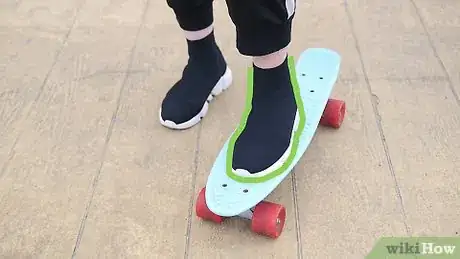


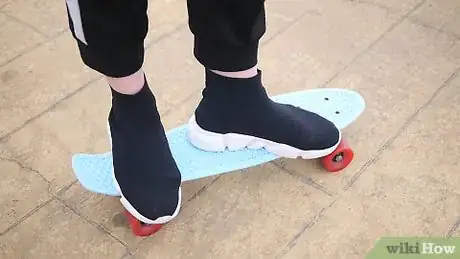


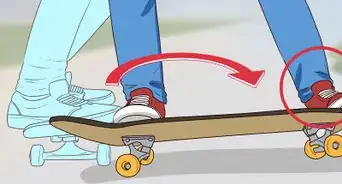

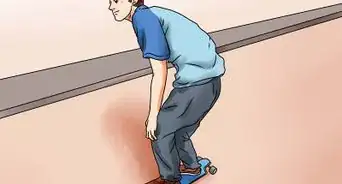

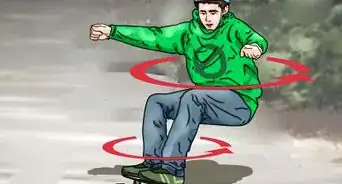

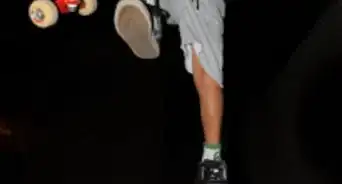










-Step-17-Version-4.webp)




































